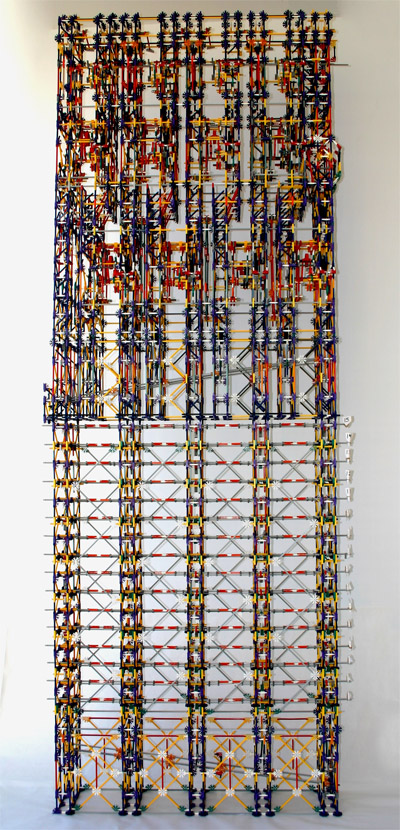KNEX Calculator
 The K'NEX calculator stands over 10 feet tall, and can perform 4 bit addition and subtraction operations in about 30 seconds. The slowest part of the operation is the user entering the balls. From there the balls trickle down, computing the result of the operation, and then sending that through a 4 bit decoder, which flips a flag that tells the user the answer. Since it is 4 bit, we can add and subtract numbers from 0 to 15.
The calculator uses 9 balls to perform a computation: 4 for the first number, 1 for the operation (add or subtract) and 4 for the second number. The first ball to go in also resets all the display flags.
As the balls enter, they go into different logic gates, setting states and waiting. For more information on how the gates work, check out the Ball Theory section.
The denser looking, top half of the machine is the adder / subtracter. It outputs a 4-bit binary answer. Under that is the 4-bit binary decoder which displays the answer in decimal on a flag.
The K'NEX calculator stands over 10 feet tall, and can perform 4 bit addition and subtraction operations in about 30 seconds. The slowest part of the operation is the user entering the balls. From there the balls trickle down, computing the result of the operation, and then sending that through a 4 bit decoder, which flips a flag that tells the user the answer. Since it is 4 bit, we can add and subtract numbers from 0 to 15.
The calculator uses 9 balls to perform a computation: 4 for the first number, 1 for the operation (add or subtract) and 4 for the second number. The first ball to go in also resets all the display flags.
As the balls enter, they go into different logic gates, setting states and waiting. For more information on how the gates work, check out the Ball Theory section.
The denser looking, top half of the machine is the adder / subtracter. It outputs a 4-bit binary answer. Under that is the 4-bit binary decoder which displays the answer in decimal on a flag.
21 comments:
Great job, guys!
that has got to be the most amazing thing I have ever seen made out of knex! I have been trying to build a knex calculator for about 8 years now, and I eventually came to the conclusion that said calculator would be the size of a small room. I was working along the lines of a ball powered system, but I could not quite get it to work. I did eventually make a calculator that could add/subtract the numbers 1-4, biggest output being 8.
ok... I dont know what is going on, I am not the voom... I dont know who is... wtf
who are you then, if not the voom?
Hey Matt,
It's your cousin Mark from Boston. I was just reading the make blog and saw this on there. This thing is awesome!
Very nice creation! Can you make a video of the machine while it is adding or subtracting some numbers? It would be a nice way of showing how the machine performs its computations!
Yes, please provide a video! Very cool!
Please, please, post high-res bittorrent videos as well!!! Thanks and kudos on achieving something so cool!
FYI, you are now on reddit!
I've seen it in the stairwell - seems like it should somehow be secured to the wall if that is where it is to stay.
Brilliant achievement, but does it run Linux...:-)
One might say it has "balls" ?...
Maybe not...
Hopefully I will not be posting as the voom now, anyways, I have finally figured out how to build something like this! I currently have a working 7 bit adder, which can produce results as high as 127. My machine stands about 4.5 feet tall and 4.5 feet wide, because it does not have the binary-decimal converter.
gaa! it still says I'm the voom, anyways, it should say Austin Granger, oh well...
this project is obviously inspired by Babbage's difference engine:
http://en.wikipedia.org/wiki/Difference_engine
it would be really cool on your "ball theory" page if you compared your machine to his. Maybe just on how you carry out logical operations. In general, though - awesome work!
so, if that is the ALU how big is the CPU going to be?
Excellent ! Well done (and what an effort to actiually put together eand make it work!)
George Berbeco
President's Council
This is AMAZING! I dont even know how i found this page (I started out researching WW1 and somehow ended up here???) but I'm applying to your college now (still in high school). really neat idea though.
That is incredible not to mention a ton of parts! I'd love to put some images of this calculator on my Knex web site. Feel free to upload any other pictures you have of your models at Knex Toy Zone.
You should drop all the balls in all the slots and get all the answers at once. A quantum knex computer! :)
computer
repair in fontana
Stunning!But as Nat pointed out, if this is the ALU, how big is the CPU going to be? And can you please post some good resolution videos of the knex calculator in action. I am pretty excited at seeing it work. Keep up the good work!
hey how did you make it
great man
Post a Comment